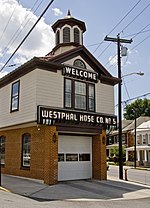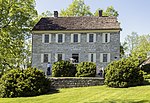Baltimore and Ohio and Related Industries Historic District

The Baltimore and Ohio Related Industries Historic District comprises a portion of Martinsburg, West Virginia to either side of the Baltimore and Ohio Railroad line as it runs through the city. The district includes the Baltimore and Ohio Railroad Martinsburg Shops, a National Historic Landmark, and a variety of industrial and commercial concerns that depended on the railroad. Along with buildings, the district includes the infrastructure associated with the building of the railroad in an urbanizing environment, such as the channelizing of Tuscarora Creek and a variety of culverts, underpasses and retaining walls. Significant buildings include, apart from the roundhouse/shop complex, the B. & O. Railroad station and hotel. Industrial buildings include coal yards, a plaster mill, feed mills, a distillery and other manufacturing facilities.
Excerpt from the Wikipedia article Baltimore and Ohio and Related Industries Historic District (License: CC BY-SA 3.0, Authors, Images).Baltimore and Ohio and Related Industries Historic District
Exchange Place, Martinsburg
Geographical coordinates (GPS) Address Nearby Places Show on map
Geographical coordinates (GPS)
| Latitude | Longitude |
|---|---|
| N 39.461944444444 ° | E -77.9625 ° |
Address
Exchange Place 146
25401 Martinsburg
West Virginia, United States
Open on Google Maps










